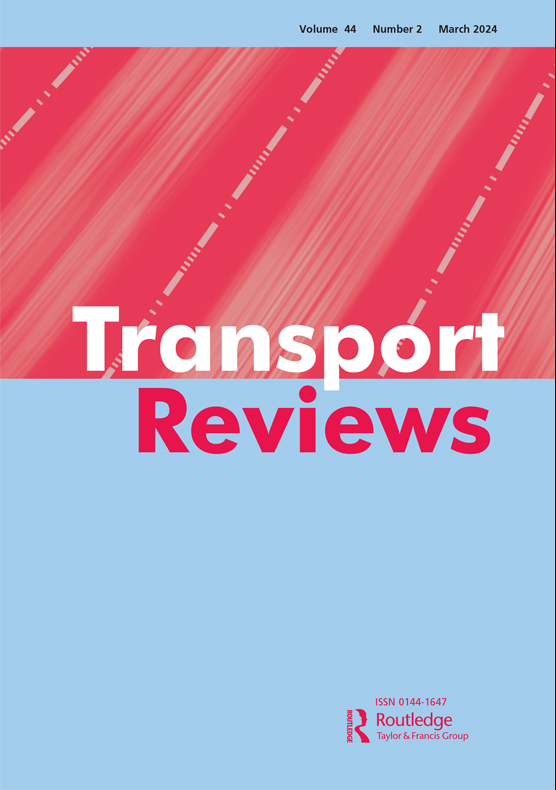使用GSR分析城市骑自行车者的行为:范围审查
IF 9.9
1区 工程技术
Q1 TRANSPORTATION
引用次数: 0
摘要
迫切需要促进可持续的交通方式,如自行车,这是一个全球共识。这一认识伴随着对骑自行车者行为的研究的增加,从而有效地规划自行车友好型道路基础设施。本研究中常用的一些数据收集方法包括调查和访谈,这有助于捕捉骑自行车者的感知和有意识的行为。然而,这些数据收集方法容易受到报告和假设偏差的影响。因此,最近的研究开始探索使用生理测量,如皮肤电反应(GSR),作为骑自行车者潜意识行为的客观测量。GSR有可能捕捉骑车者的感知压力,并且可以使用基于传感器的可穿戴设备轻松记录。为了处理和分析这样收集的数据,必须确定适当的统计工具。以前的研究已经详细讨论了在城市骑自行车者行为分析中使用GSR的优点、缺点、范围和局限性。然而,在这一领域的未来研究中,方法上的进步需要对当前使用的统计方法和工具有一个全面的了解。这篇综述通过提供这些方法和工具的概述,并根据其目的(方法论探索或刺激反应分析),方法方法(归纳或演绎),数据处理方法(分裂GSR信号,计数GSR峰值,测量GSR峰值,取GSR Log或曲线拟合)和数据分析方法(地图匹配,描述性分析,假设检验或广义线性建模)对现有研究进行分类,从而为他们提供便利。该综述进一步得出结论,未来的研究需要在要保存的GSR数据的粒度(考虑到更高的粒度确保分析中更高的细节水平)和由于其程序和计算复杂性而导致的资源消耗之间找到正确的平衡。本文章由计算机程序翻译,如有差异,请以英文原文为准。
Analysis of urban cyclists’ behaviour using GSR: a scoping review
There is a global consensus on the urgent need to promote sustainable modes of mobility such as the bicycle. This realisation is accompanied by an increased promotion of the research on bicyclists’ behaviour to plan bicycle-friendly road infrastructure effectively. Some of the commonly used methods of data collection in this research include surveys and interviews, which help in capturing the cyclists’ perceptions and conscious behaviour. However, these data collection methods are susceptible to reporting and hypothetical biases. Hence, recent studies have started exploring the use of physiological measures, such as the Galvanic Skin Response (GSR), as the objective measures of cyclists’ subconscious behaviour. The GSR potentially captures the perceived stress of the cyclists and can be easily recorded using sensor-based wearables. For the processing and analysis of the data thus collected, it is necessary to identify the appropriate statistical tools. Previous studies have discussed the merits, demerits, scope, and limitations of using GSR in urban cyclists’ behaviour analysis at length. However, methodological advancements expected in future studies in this domain need a comprehensive understanding of the currently used statistical methods and tools to build upon. This review facilitates them by providing an overview of these methods and tools, and by categorising existing studies based on their purpose (Methodological Exploration or Stimuli Response Analysis), methodological approach (Inductive or Deductive), method of data processing (splitting GSR signal, counting GSR peaks, measuring GSR peaks, taking Log of GSR, or curve fitting), and method of data analysis (map matching, descriptive analysis, hypothesis testing or Generalized Linear Modelling). The review further concludes that future studies need to find the correct balance between the granularity of GSR data to be preserved (given higher granularity ensures a higher level of detail in the analysis) and the resource consumption owing to its procedural and computational complexity.
求助全文
通过发布文献求助,成功后即可免费获取论文全文。
去求助
来源期刊

Transport Reviews
TRANSPORTATION-
CiteScore
17.70
自引率
1.00%
发文量
32
期刊介绍:
Transport Reviews is an international journal that comprehensively covers all aspects of transportation. It offers authoritative and current research-based reviews on transportation-related topics, catering to a knowledgeable audience while also being accessible to a wide readership.
Encouraging submissions from diverse disciplinary perspectives such as economics and engineering, as well as various subject areas like social issues and the environment, Transport Reviews welcomes contributions employing different methodological approaches, including modeling, qualitative methods, or mixed-methods. The reviews typically introduce new methodologies, analyses, innovative viewpoints, and original data, although they are not limited to research-based content.
 求助内容:
求助内容: 应助结果提醒方式:
应助结果提醒方式:


